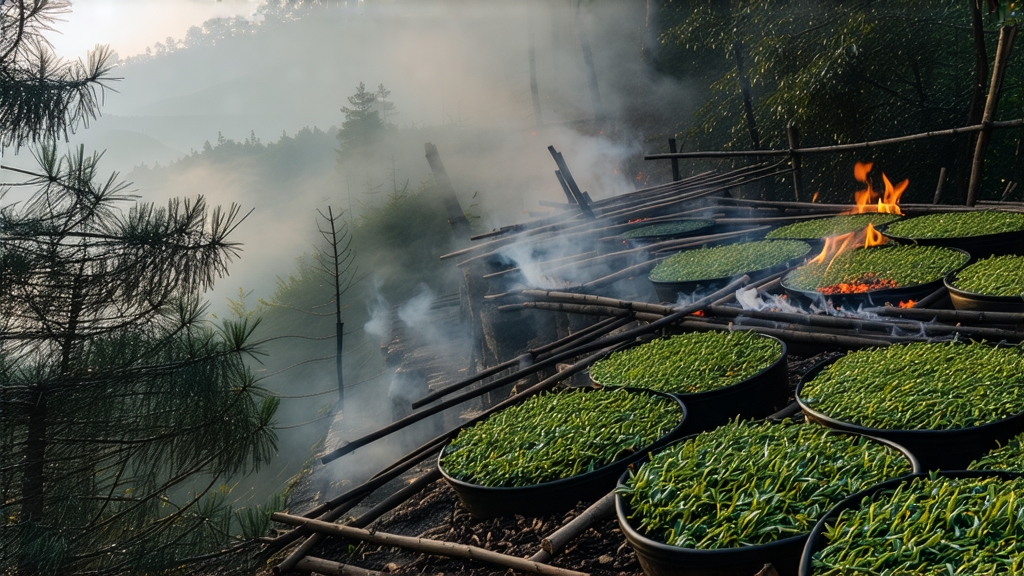
Ask most tea lovers to name a Chinese black tea and they will answer Keemun or Dian Hong; mention Lapsang Souchong and you are more likely to meet raised eyebrows and the word “smoky”. Yet this small, rugged leaf from the Wuyi massif in north-west Fujian is the very first black tea ever created, the prototype that launched the global category we now call “red tea” in China and “black tea” everywhere else. Its story begins in the late Ming dynasty, around 1604, when soldiers passing through the tea-producing village of Tongmu delayed the normal green-tea drying schedule. In haste to meet market deadlines, villagers spread the half-oxidised leaves over fires of fresh pinewood, inadvertently fixing both colour and flavour. Dutch traders tasting the result in Xiamen’s port bought every chest, shipped it to Amsterdam, and christened it “bohea” after the local dialect word for Wuyi. Within decades Europe’s tea cups turned from green to black, and the British East India Company began the long quest to steal the secret, culminating in Robert Fortune’s espionage mission of 1848. Thus Lapsang Souchong is not merely a curiosity; it is the single leaf that redirected maritime history, funded clipper ships, and seeded the Indian tea industry.
Geography still defines authenticity. Only leaf picked within the 600–1,200 m core zone of Tongmu Nature Reserve—an area of 56 km² cloaked in humid subtropical forest—may legally be sold as “Zheng Shan Xiao Zhong”, the protected designation of origin. Here, morning fog diffuses sunlight into a soft, silver glow, slowing photosynthesis and concentrating amino acids. The soil is a friable, mineral-rich laterite born from weathered volcanic tuff, while the canyon air carries perpetual whispers of pine, cedar, and wild orchid. Indigenous cultivars such as Cai Cha (purple leaf) and Ye Sheng (wild shrub) root directly into rock crevices, yielding a mere 300 g of finished tea per mature bush each spring, less than a single tin.
Two styles now share the name. Traditional Lapsang Souchong is withered over pine embers, rolled, oxidised 80–90 %, then smoked in wooden chambers where resinous Masson and Chinese red pine logs smoulder below bamboo trays. The smoke is cool, 30–35 °C, so leaves dry slowly, absorbing sweet, terpenic aromas without acrid tar. Craftsmen gauge readiness by sound: when the crackle of a handful pressed to the ear resembles distant pine cones popping, firing ends. The modern “unsmoked” or “craft” version omits the final smoking, allowing the honeyed, longan-fruit character of the high-mountain leaf to speak directly. Both styles pass through the same eight steps—pluck, solar wither, indoor wither, rolling, oxidisation, preliminary bake, sorting, and final smoke or charcoal bake—but the duration of each and the fuel source differ, creating teas that share a genetic lineage yet diverge like cousins raised on separate continents.
To brew the classic smoked version, begin with soft, neutral water. Pre-warm a thin-walled porcelain gaiwan or small Yixing pot; heat releases residual pine oils that might otherwise dominate. Measure 4 g of leaf for 120 ml, roughly two level teaspoons. Flash-rinse for three seconds to awaken the leaf and discard the rinse; this removes surface smoke and invites the deeper, malty sweetness underneath. Use water at 95 °C, pouring in a thin, high stream to aerate. Steep 5 s, 5 s, 7 s, 10 s, 15 s, adding five seconds each subsequent infusion. Expect at least eight steeps: the first presents dried longan and campfire, the second cocoa and tannic grip, the third a surprising note of cinnamon bark, while later infusions drift toward resinous pine honey and cooling camphor. If you prefer Western style, 2.5 g per 250 ml for three minutes yields a copper liquor tasting of smoked caramel; a second three-minute steep is possible but will be softer.
Tasting follows a three-stage ritual borrowed from the Tongmu elders. First, inhale the “dry aroma” by shaking warm leaf in an empty gaiwan lid; look for the balance between pine and fruit—too much smoke suggests hurried production. Second, sip loudly, aerating the liquor across the palate; a good Lapsang coats